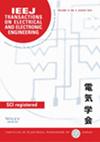求助PDF
{"title":"使用智能电表的配电线路短路点估算方法","authors":"Yasuhiro Kodama, Kenji Otani","doi":"10.1002/tee.24162","DOIUrl":null,"url":null,"abstract":"<p>The presence of a substantial short-circuit current generates a large electromagnetic repulsive force. The energy of such a short-circuit current increases the likelihood of equipment damage. Furthermore, the occurrence of short-circuits disrupts the stable supply of electric power. When a short-circuit occurs in a distribution line, short-circuit point identification is realized based on information such as overcurrent indicators and equipment damage caused by the short-circuit. However, there is no established method for promptly pinpointing the short-circuit location. Therefore, this study proposes a short-circuit point estimation method for distribution lines using smart-meters; whose performance is anticipated to improve in the future. The proposed method involved using smart-meter voltage measurements to measure and determine the changes in the voltage drop slope, caused by the distribution-substation short-circuit currents and load currents, from the short-circuit location to the end point. © 2024 Institute of Electrical Engineers of Japan and Wiley Periodicals LLC.</p>","PeriodicalId":13435,"journal":{"name":"IEEJ Transactions on Electrical and Electronic Engineering","volume":"19 12","pages":"1976-1986"},"PeriodicalIF":1.0000,"publicationDate":"2024-07-11","publicationTypes":"Journal Article","fieldsOfStudy":null,"isOpenAccess":false,"openAccessPdf":"","citationCount":"0","resultStr":"{\"title\":\"Short-Circuit Point Estimation Method for Distribution Lines Using Smart-Meters\",\"authors\":\"Yasuhiro Kodama, Kenji Otani\",\"doi\":\"10.1002/tee.24162\",\"DOIUrl\":null,\"url\":null,\"abstract\":\"<p>The presence of a substantial short-circuit current generates a large electromagnetic repulsive force. The energy of such a short-circuit current increases the likelihood of equipment damage. Furthermore, the occurrence of short-circuits disrupts the stable supply of electric power. When a short-circuit occurs in a distribution line, short-circuit point identification is realized based on information such as overcurrent indicators and equipment damage caused by the short-circuit. However, there is no established method for promptly pinpointing the short-circuit location. Therefore, this study proposes a short-circuit point estimation method for distribution lines using smart-meters; whose performance is anticipated to improve in the future. The proposed method involved using smart-meter voltage measurements to measure and determine the changes in the voltage drop slope, caused by the distribution-substation short-circuit currents and load currents, from the short-circuit location to the end point. © 2024 Institute of Electrical Engineers of Japan and Wiley Periodicals LLC.</p>\",\"PeriodicalId\":13435,\"journal\":{\"name\":\"IEEJ Transactions on Electrical and Electronic Engineering\",\"volume\":\"19 12\",\"pages\":\"1976-1986\"},\"PeriodicalIF\":1.0000,\"publicationDate\":\"2024-07-11\",\"publicationTypes\":\"Journal Article\",\"fieldsOfStudy\":null,\"isOpenAccess\":false,\"openAccessPdf\":\"\",\"citationCount\":\"0\",\"resultStr\":null,\"platform\":\"Semanticscholar\",\"paperid\":null,\"PeriodicalName\":\"IEEJ Transactions on Electrical and Electronic Engineering\",\"FirstCategoryId\":\"5\",\"ListUrlMain\":\"https://onlinelibrary.wiley.com/doi/10.1002/tee.24162\",\"RegionNum\":4,\"RegionCategory\":\"工程技术\",\"ArticlePicture\":[],\"TitleCN\":null,\"AbstractTextCN\":null,\"PMCID\":null,\"EPubDate\":\"\",\"PubModel\":\"\",\"JCR\":\"Q4\",\"JCRName\":\"ENGINEERING, ELECTRICAL & ELECTRONIC\",\"Score\":null,\"Total\":0}","platform":"Semanticscholar","paperid":null,"PeriodicalName":"IEEJ Transactions on Electrical and Electronic Engineering","FirstCategoryId":"5","ListUrlMain":"https://onlinelibrary.wiley.com/doi/10.1002/tee.24162","RegionNum":4,"RegionCategory":"工程技术","ArticlePicture":[],"TitleCN":null,"AbstractTextCN":null,"PMCID":null,"EPubDate":"","PubModel":"","JCR":"Q4","JCRName":"ENGINEERING, ELECTRICAL & ELECTRONIC","Score":null,"Total":0}
引用次数: 0
引用
批量引用

 求助内容:
求助内容: 应助结果提醒方式:
应助结果提醒方式:


